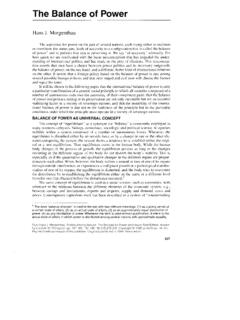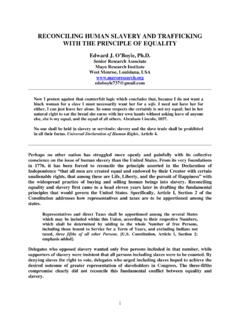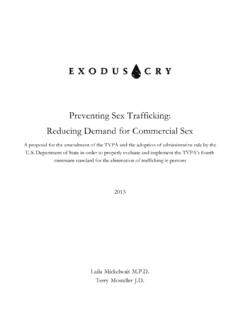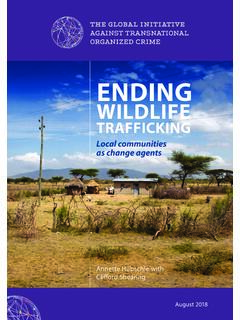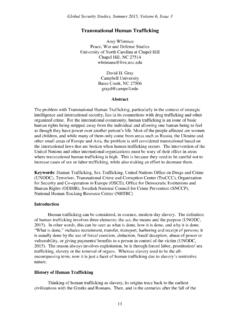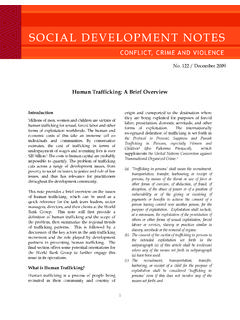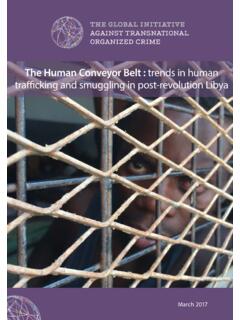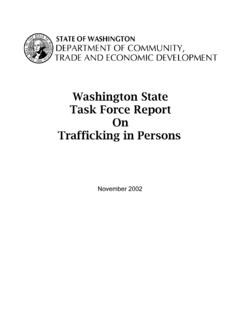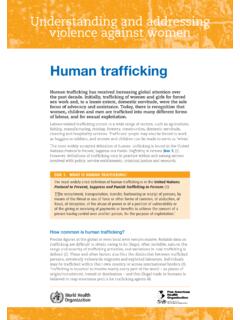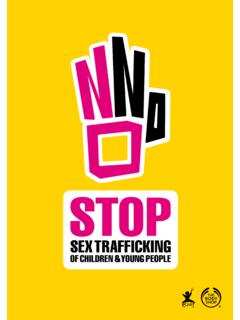Transcription of Globalization and Human Trafficking - Blackboard Learn
1 Globalization and Human Traffickingloring Jonesdavid w. engstroMtricia hilliardMariel diazSan Diego State University School of Social WorkGlobalization demands that social workers embrace more than just local and national perspectives; they must adopt an internation-al viewpoint as well. A negative aspect of Globalization that de-serves more attention is the international movement of labor. This paper presents a description and analysis of Trafficking , the more deleterious part of this movement of people, in a global context. Decision makers seeking to make global migration more humane need to know about the dynamics and process of Trafficking , as well as ways to combat it.
2 Definitional controversies, contex-tual issues (including the dynamics and processes of Trafficking ), and consequences of this movement for individuals and societ-ies are discussed. Implications for social work are also : Human Trafficking , global migration, labor exploita-tion , international labor movement IntroductionGlobalization has resulted in an unprecedented flow of capital, goods and services, and labor into every continent and Journal of Sociology & Social Welfare, June 2007, Volume XXXIV, Number 2107108 Journal of Sociology & Social Welfarenearly every country in the world. Although much has been written on capital flows and emerging markets (Friedman, 2000), not as much attention has been given to the tremendous flow of people seeking work outside of their home countries.
3 Indeed, in 2006 the International Organization for Migration estimated that there were more than 191 million immigrants worldwide (IOM, 2006). Immigrants are frequently treated as outsiders in their host countries and not afforded the same protection and rights as citizens (Engstrom, 2006; Aleinikoff & Klusmeyer, 2002). In part because of their outsider status, im-migrants are particularly vulnerable to exploitation and other harms, and nowhere is this more apparent than in Human traf-ficking, a violation of basic Human rights that is aptly viewed as a modern form of slavery. Human Trafficking represents perhaps the worst form of labor exploitation and can be re-garded as one of the dark sides of supplies Human beings for prostitution, sweat-shop labor, street begging, domestic work, marriage, adoption, agricultural work, construction, armed conflicts (child soldiers), and other forms of exploitive labor or services.
4 Estimating with any accuracy the number of victims of Human Trafficking is a daunting task, so much so that the United Nations Office on Drugs and Crime stated that such a statistical goal may prove to be unachievable (UNODC, 2006, p. 45). Methodological problems have not, however, prevented organizations and scholars from offering widely ranging estimates. For example, a 2005 report by the International Labor Organization said that there were approximately 12,300,000 victims in forced labor in the world (ILO, 2005), while Bales (2005) offered an estimate of 27 million. There is general agreement that the majority of persons trafficked are female, perhaps nearly 80 percent (UNODC, 2006).
5 Labor exploitation of trafficked persons is hugely profit-able. One estimate places the global profits at approximately $32 billion annually (Feingold, 2005). The Department of Health and Human Services (US DHHS) described Trafficking as the fastest growing criminal industry in the world (2004). Among illegal enterprises, Trafficking is second only to drug dealing, and tied with the illegal arms industry, in its ability to generate Trafficking is both a global problem and a 109domestic problem. The United States is a major receiver of traf-ficked persons: It is estimated that 15,000 to 50,000 of inter-nationally trafficked victims arrive in the United States each year (United States Department of State [US DOS], 2005; US DHHS, 2004; UNODC, 2006).
6 Trafficked victims can be found in various sectors of the economy, including prostitution, sweatshops, factories, and service industry work (US DHHS, 2004). These data demonstrate the scope of the problem. Human Trafficking is a highly underreported crime and victims can be extremely difficult to identify (Hopper, 2004). Due to the crim-inal, secretive nature of Human Trafficking , victims are often hidden in brothels, homes, and businesses. Moreover, law en-forcement, social workers, health care professionals, and other authorities rarely encounter victims of Human Trafficking , both because they are frequently unaware of how to identify poten-tial victims and because victims are intentionally kept out of sight (Diaz, 2006).
7 Even if victims do come into contact with law enforcement or social services, they are usually reluctant to ask for help, partly as a result of psychological coercion but also because they fear retribution from the trafficker (United States Department of Justice [US DOJ], 2006). Many victims come from countries with oppressive governments and are therefore fearful of any type of government official or author-ity figure ( Human Rights Center, 2004).Those who are trafficked are among the most vulner-able and exploited individuals in the new global economy that spawned this phenomenon. Now more than ever, social workers need a global perspective (Healy, 2001) to understand the issues that are contributing to international migration, in-cluding the problem and dynamics of Human Trafficking .
8 Social workers need to recognize that some of the thousands of traf-ficked people in the United States will end up as our clients in emergency rooms, domestic violence shelters, mental health facilities, and child welfare systems. To intervene effectively, social workers must become aware of the realities of traffick-ing. Decision makers seeking to make global migration more humane also need to know about the dynamics and process of Trafficking , as well as ways to combat it. It is within this framework of Trafficking in a global context that this paper is and Human Trafficking110 Journal of Sociology & Social WelfareTrafficking DefinedDefining Trafficking can be difficult.
9 There is no single, universally accepted definition of Trafficking (Arnold & Bertone, 2002; IMO, 2000). Trafficking is often confused with smuggling or illegal immigration; it is not synonymous with either, but may involve both. Smuggling can be defined as the facilita-tion, transportation, attempted transportation, or illegal entry of a person or persons across an international border in viola-tion of American immigration laws (US DOJ, 2006, pp. 9-10). Sometimes smuggling can turn into Trafficking : for example, when people pay to be smuggled into a country, but once there, find that they owe a large debt and are not free to leave. Human traffickers and Human smugglers often work together to supply the labor market with workers (Cole, 2005).
10 Definitions of Trafficking found in international and national law emphasize the elements of deception, fraud, and coercion for the purpose of exploitation. The UN defines Human traf-ficking as:the recruitment, transportation, transfer, harboring or receipt of persons, by means of threat or use of force or other forms of coercion, of abduction, of fraud, of deception, of the abuse of power or of a position of vulnerability or of the giving or receiving of payments or benefits to achieve the consent of a person having control over another person, for the purpose of exploitation. Exploitation shall include, at a minimum, .. the prostitution of others or other forms of sexual exploitation, forced labor or services, slavery or practices similar to slavery, servitude or the removal of organs (UN, 2000, art.)


